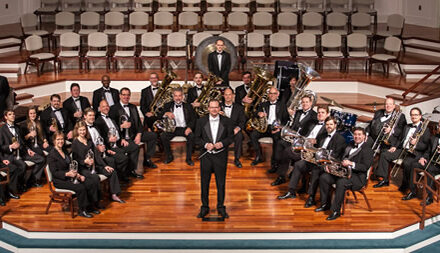Perhaps the juxtaposition of University Day (October 12), with its installation ceremonies for UNC’s new Chancellor, Holden Thorp, inspired conductor Tonu Kalam’s choice of repertoire for the UNC Symphony Orchestra‘s first concert of the season. Thorp is an accomplished musician — not classical, but he plays jazz bass and keyboard. For the first time in my Carolina experience (since 1967), a chancellor has star power. These fine concerts are too often attended merely by friends of the musicians and a scattering of townies. This time, two huge lines snaked away from the Memorial Hall box office and only dwindled as the house light were flashed! Both the orchestra and balcony sections of the Beasley-Curtis Auditorium had plenty of attentive listeners.
Like the Duke University Symphony, the UNCG Symphony, and the UNC School of the Arts Symphony, the concert program notes are written by music students. Jeffrey Wright’s extensive note for “Lincoln Portrait” (1942) by Aaron Copland was unusually informative, including facts I had forgotten and new details about its origin. Ten days after the Japanese attack on Pearl Harbor, musical arranger/conductor André Kostelanetz commissioned composers Jerome Kern, Virgil Thomson, and Copland, to write works celebrating great Americans. After Kern chose Mark Twain, Copland opted for President Abraham Lincoln.
The extended orchestral introduction to “Lincoln Portrait” features what has become known as the “Copland Sound,” consisting of “wide intervals, open harmonies, and chorale-like homophonic textures.” A speaker declaims a mixture of excerpts from the 16th president’s speeches, interspersed with biographical details. Of the three Kostelanetz commissions, Copland’s work has remained an audience favorite, widely performed on major national holidays and at pops concerts, often using a local celebrity or politician… with wildly varying musical results. Chancellor Thorp delivered the text with quiet dignity and with great care for words. His voice was skillfully amplified. Music Director and Conductor Tonu Kalam kept the ensemble tight while carefully balancing the dynamics and phrasing stylishly. After fleeting, minor intonation problems during the slow opening, his musicians played with great confidence and flair. Each of the large string sections played as one with a good, full tone, especially the violas. There was some very fine muted trumpet playing from one of the players while his stand mate’s solo was given with confidence.
Love and death haunted the creation of Neruda Songs (2005) by Peter Lieberson (b.1946). The composer dedicated these settings of five love poems by Chilean writer Pablo Neruda for soprano and orchestra to his wife, Lorraine Hunt Lieberson. Lieberson knew his wife was dying of breast cancer when he composed these pieces. She was a great mezzo-soprano, especially in the operas of Handel, and she premiered the set with co-commissioners Boston Symphony Orchestra and the Los Angeles Philharmonic before her premature death in July 2006. (A recording of the Boston performance, led by James Levine, is available on CD.) Full texts and translations were included in UNC’s concert program but hall lights were not raised during the performance to allow these to be followed. In “Peter Lieberson Wins 2008 Grawemeyer Award for Neruda Songs” in the December 3, 2007, issue of Playbill Arts, Matthew Westphal reports that the composer “is now working on a second Neruda cycle, this time for baritone. Yet he is himself now battling lymphoma.”
The five poems are identified by Roman numerals and are: VIII “Si no fuera porque tus ojos tienen color de luna” (“If your eyes were not the color of the moon”), XXIV “Amor, amor, las nubes a la torre del cielo” (“Love, love, the clouds went up the tower of the sky”), XLV “No estés lejos de mí un solo día, porque cómo” (“Don’t go far off, not even for a day, because…”), LXXXI “Ya eres mía. Resposa con tu sueño en mi sueño.” (“And now you’re mine. Rest with your dream in my dream”), and XCII “Amor mío, si muero y tú no mueres” (“My love, if I die and you don’t…”). Soprano Terry Rhodes was in good voice, easily projecting the words, singing with an evenly balanced voice and with clear diction. The emotions of each poem were readily conveyed by her careful attention to dynamics and timbre. There were fine solos by horn and oboe. Subtle playing by the whole orchestra brought out the wonderful gossamer quality of Lieberson’s score. (Kalam rotated extra musicians, particularly woodwinds, into the orchestra for each major composition.)
Under Kalam’s stylish direction, his student musicians played the socks off the Suite No. 2 from Daphnis et Chloé (1912) by Maurice Ravel (1875-1937). The woodwinds were terrific, and it was great to see and hear the alto flute, which is shaped like a “J” as sketched by El Greco. The flute solos were beautifully focused. The brass section’s work was excellent, and the horns played on a very professional level. The string harmonics were crystal clear.











